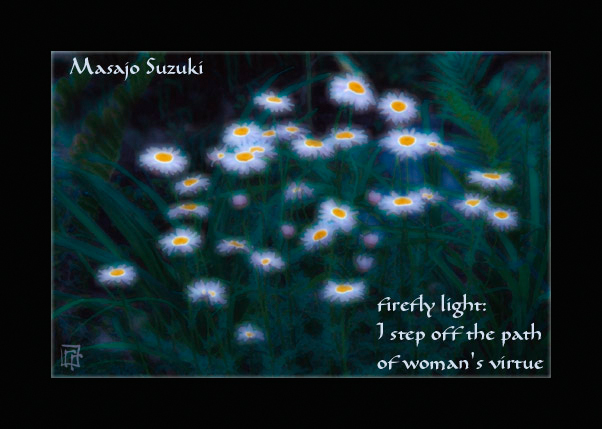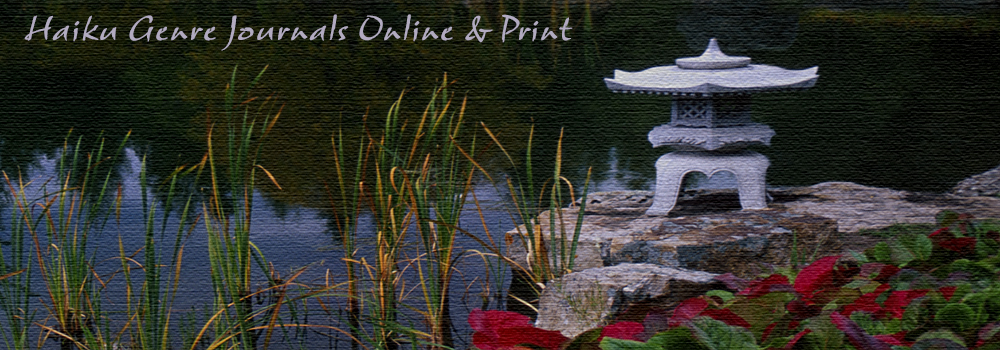| Journal Links | Haiku, Haiga, Haibun Resources | Haibun & Tanka Prose Resources | Haiga Links Page | Homepage | Email |
Definitions of Haiku, Haibun, Haiga, Tanka
The following are brief definitions of each of the English-language genres derived and changed considerably from their original Japanese forms: haiku, haibun, haiga and tanka.
For more comprehensive definitions, see the Haiku Society of America Definitions, the Tanka Society of American Definitions, and Stephen Addiss' "A Brief History of Haiga."
 Haiku: A haiku is a short poem that uses descriptive langage to convey the essence of a human experience wherever that may occur. Most modern English language consist of three lines with two phrases whose connection forums the spark of this poetic form. In Japanese, haiku have 17 sound units (on) aranged in three 5-7-5 lines. Most modern English language haiku contain about 13 syllables which roughly corresponds to 17 Japanese language sound units and the number of syllables in each line varies. Haiku: A haiku is a short poem that uses descriptive langage to convey the essence of a human experience wherever that may occur. Most modern English language consist of three lines with two phrases whose connection forums the spark of this poetic form. In Japanese, haiku have 17 sound units (on) aranged in three 5-7-5 lines. Most modern English language haiku contain about 13 syllables which roughly corresponds to 17 Japanese language sound units and the number of syllables in each line varies.
Haiku Example:
spring sun
cedar waxwings fill
the leafless plum
(published in The Heron's Nest)
Line 1 is a distinct phrase with 2 syllables and a natural pause or break.
Lines 2 and 3 comprise the second phrase (cedar waxwings fill the leafless plum) which is paired with the Line 1 phrase (spring sun). Line 2 has 5 syllables and Line 3 has 4 syllables.
 A related form is Senryu, a poem that is structurally similar to haiku and with a focus on human situations and typically employs humour or satire. A related form is Senryu, a poem that is structurally similar to haiku and with a focus on human situations and typically employs humour or satire.
Senryu Example:
meditation class
he begins by comtemplating
the blonde's navel
(published in Simply Haiku)
 Haibun: A haibun is a mix of prose and one or more haiku. The title, prose and haiku work together to form the spark of this form. The prose is typically succinct, almost haiku-like. The focus of the prose can be on a travel experience or a smaller, more discrete human experience. Some modern writers include fantasy, dreams, remembrances as their subjects. A related form is Tanka Prose, which is a mix of prose and one or more tanka poems (and sometimes mixed with haiku poems). Haibun: A haibun is a mix of prose and one or more haiku. The title, prose and haiku work together to form the spark of this form. The prose is typically succinct, almost haiku-like. The focus of the prose can be on a travel experience or a smaller, more discrete human experience. Some modern writers include fantasy, dreams, remembrances as their subjects. A related form is Tanka Prose, which is a mix of prose and one or more tanka poems (and sometimes mixed with haiku poems).
Example:
Warmth
I miss them, my daughters when they were young. Reading The Hobbit in wintertime, snuggled in close, bodies and fire keeping us warm, rewarded with their pleas . . . just one more page. I've nearly forgotten my reluctance to pick up the book in the first place.
I don't remember being read to, but when I was sick, my mother sang lullabies while tucking me deep under the covers, only my nose and ears sticking out. I remember the melodies, but not the words.
old friends—
I place more wood
on the campfire
(Published in Modern Haiku)
 Haiga: Modern haiga are a mix of image and haiku poetry. The haiku may be place on or next to the image. Haiga artists utilize a variety of mediums, paintings, photography and digital-art. Just as the haiku in haibun serves as a link to and contrast with the prose in a haibun, so does the haiku in haiga compositions work to create the spark that makes haiga work and that differentiates it from pure artwork. Haiga: Modern haiga are a mix of image and haiku poetry. The haiku may be place on or next to the image. Haiga artists utilize a variety of mediums, paintings, photography and digital-art. Just as the haiku in haibun serves as a link to and contrast with the prose in a haibun, so does the haiku in haiga compositions work to create the spark that makes haiga work and that differentiates it from pure artwork.
Example: haiku by Masajo Suzuki, composition and digital artwork by Ray Rasmussen.

 Tanka: A tanka is a short 5-line poem. Most modern English language tanka consist of 31 or fewer syllables which compares to the Japanese form of 5/7/5/7/7 Japanese sound units. Modern English language writers may or may not follow a short/long/short/long/long pattern. Tanka: A tanka is a short 5-line poem. Most modern English language tanka consist of 31 or fewer syllables which compares to the Japanese form of 5/7/5/7/7 Japanese sound units. Modern English language writers may or may not follow a short/long/short/long/long pattern.
Example:
I let it go
the brittle fury of
bright confetti
that will now be
nobody's letter
Jeffrey Woodward, The Pebbled Shore: Tanka Society of America Anthology 2009
|

